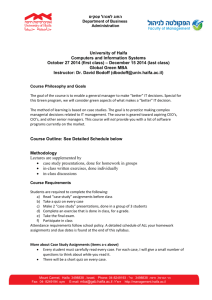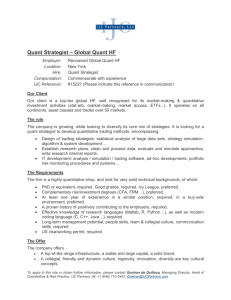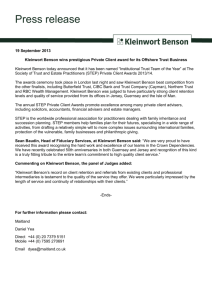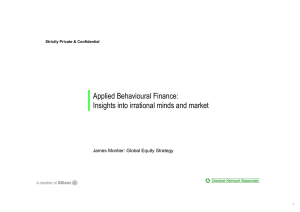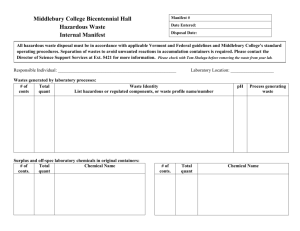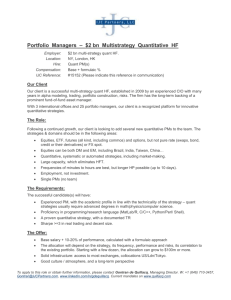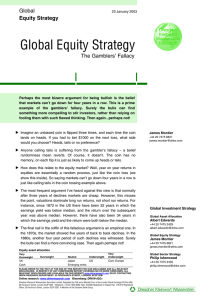Global Equity Strategy Macro research Painting by numbers: an ode to quant
advertisement
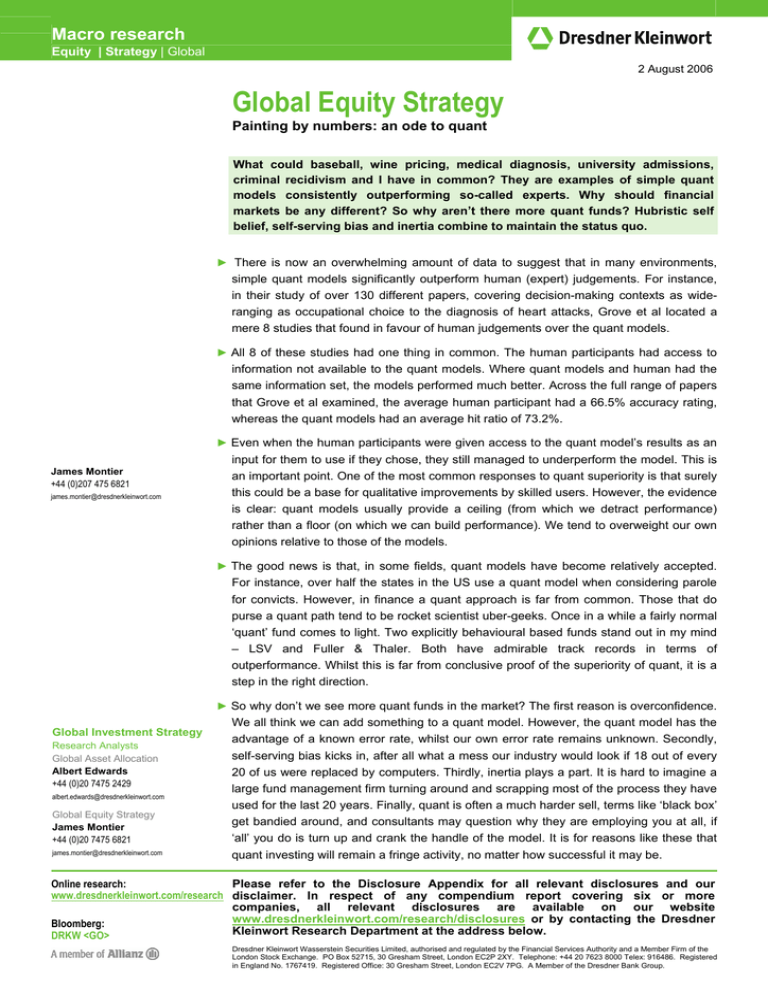
Macro research Equity | Strategy | Global 2 August 2006 Global Equity Strategy Painting by numbers: an ode to quant What could baseball, wine pricing, medical diagnosis, university admissions, criminal recidivism and I have in common? They are examples of simple quant models consistently outperforming so-called experts. Why should financial markets be any different? So why aren’t there more quant funds? Hubristic self belief, self-serving bias and inertia combine to maintain the status quo. ► There is now an overwhelming amount of data to suggest that in many environments, simple quant models significantly outperform human (expert) judgements. For instance, in their study of over 130 different papers, covering decision-making contexts as wideranging as occupational choice to the diagnosis of heart attacks, Grove et al located a mere 8 studies that found in favour of human judgements over the quant models. ► All 8 of these studies had one thing in common. The human participants had access to information not available to the quant models. Where quant models and human had the same information set, the models performed much better. Across the full range of papers that Grove et al examined, the average human participant had a 66.5% accuracy rating, whereas the quant models had an average hit ratio of 73.2%. ► Even when the human participants were given access to the quant model’s results as an James Montier +44 (0)207 475 6821 james.montier@dresdnerkleinwort.com input for them to use if they chose, they still managed to underperform the model. This is an important point. One of the most common responses to quant superiority is that surely this could be a base for qualitative improvements by skilled users. However, the evidence is clear: quant models usually provide a ceiling (from which we detract performance) rather than a floor (on which we can build performance). We tend to overweight our own opinions relative to those of the models. ► The good news is that, in some fields, quant models have become relatively accepted. For instance, over half the states in the US use a quant model when considering parole for convicts. However, in finance a quant approach is far from common. Those that do purse a quant path tend to be rocket scientist uber-geeks. Once in a while a fairly normal ‘quant’ fund comes to light. Two explicitly behavioural based funds stand out in my mind – LSV and Fuller & Thaler. Both have admirable track records in terms of outperformance. Whilst this is far from conclusive proof of the superiority of quant, it is a step in the right direction. ► So why don’t we see more quant funds in the market? The first reason is overconfidence. Global Investment Strategy Research Analysts Global Asset Allocation Albert Edwards +44 (0)20 7475 2429 albert.edwards@dresdnerkleinwort.com Global Equity Strategy James Montier +44 (0)20 7475 6821 james.montier@dresdnerkleinwort.com We all think we can add something to a quant model. However, the quant model has the advantage of a known error rate, whilst our own error rate remains unknown. Secondly, self-serving bias kicks in, after all what a mess our industry would look if 18 out of every 20 of us were replaced by computers. Thirdly, inertia plays a part. It is hard to imagine a large fund management firm turning around and scrapping most of the process they have used for the last 20 years. Finally, quant is often a much harder sell, terms like ‘black box’ get bandied around, and consultants may question why they are employing you at all, if ‘all’ you do is turn up and crank the handle of the model. It is for reasons like these that quant investing will remain a fringe activity, no matter how successful it may be. Online research: Please refer to the Disclosure Appendix for all relevant disclosures and our www.dresdnerkleinwort.com/research disclaimer. In respect of any compendium report covering six or more Bloomberg: DRKW <GO> companies, all relevant disclosures are available on our website www.dresdnerkleinwort.com/research/disclosures or by contacting the Dresdner Kleinwort Research Department at the address below. Dresdner Kleinwort Wasserstein Securities Limited, authorised and regulated by the Financial Services Authority and a Member Firm of the London Stock Exchange. PO Box 52715, 30 Gresham Street, London EC2P 2XY. Telephone: +44 20 7623 8000 Telex: 916486. Registered in England No. 1767419. Registered Office: 30 Gresham Street, London EC2V 7PG. A Member of the Dresdner Bank Group. Global Equity Strategy 2 August 2006 Painting by numbers: an ode to quant Don’t worry dear reader, there will be no gratuitous use of poetry in this missive, despite the title - I promise. However, pause for a moment and consider what baseball, wine, medical diagnosis, university admissions, criminal recidivism and I might have in common. The answer is that they all represent realms where simple statistical models have outperformed so-called experts. Long-time readers may recall that a few years ago I designed a tactical asset allocation tool based on a combination of valuation and momentum. At first this model worked just fine, generating signals in line with my own bearish disposition. However, after a few months, the model started to output bullish signals. I chose to override the model, assuming that I knew much better than it did (despite the fact that I had both designed it and back-tested it to prove it worked). Of course, much to my chagrin and the amusement of many readers, I spent about 18 months being thrashed in performance terms by my own model. This is only anecdotal (and economist George Stigler once opined “The plural of anecdote is data”), but it sets the scene for the studies to which I now turn. Neurosis or psychosis? The first study I want to discuss is a classic in the field. It centres on the diagnosis of whether someone is neurotic or psychotic. A patient suffering psychosis has lost touch with the external world; whereas someone suffering neurosis is in touch with the external world but suffering from internal emotional distress, which may be immobilising. The treatments for the two conditions are very different, so the diagnosis is not one to be taken lightly. The standard test to distinguish the two is the Minnesota Multiphasic Personality Inventory (MMPI). This consists of around 600 statements with which the patient must express either agreement or disagreement. The statements range from “At times I think I am no good at all” to “I like mechanics magazines”. Fairly obviously, those feeling depressed are much more likely to agree with the first statement than those in an upbeat mood. More bizarrely, those suffering paranoia are more likely to enjoy mechanics magazines that the rest of us! In 1968, Lewis Goldberg 1 obtained access to more than 1000 patients’ MMPI test responses and final diagnoses as neurotic or psychotic. He developed a simple statistical formula, based on 10 MMPI scores, to predict the final diagnosis. His model was roughly 70% accurate when applied out of sample. Goldberg then gave MMPI scores to experienced and inexperienced clinical psychologists and asked them to diagnose the patient. As the chart below shows, the simple quant rule significantly outperformed even the best of the psychologists. 1 Goldberg (1968) Simple models or simple processes? Some research on clinical judgements, American Psychologist, 23 2 Global Equity Strategy 2 August 2006 Hit rate for diagnosis (%) 75 70 65 60 55 50 Quant model Average psychologist Best psychologist Worst psychologist Source: Dresdner Kleinwort Macro research Even when the results of the rules’ predictions were made available to the psychologists, they still underperformed the model. This is a very important point: much as we all like to think we can add something to the quant model output, the truth is that very often quant models represent a ceiling in performance (from which we detract) rather than a floor (to which we can add). Every so often, and always with the aid of a member of the quant team, I publish a quant note in Global Equity Strategy. The last one was based on the little book that beats the market (see Global Equity Strategy, 9 March 2006). Whenever we produce such a note, the standard response from fund managers is to ask for a list of stocks that the model would suggest. I can’t help but wonder if the findings above apply here as well. Do the fund managers who receive the lists then pick the ones that they like, much like the psychologists above selectively using the Goldberg rule as an input? Brain damage detection Similar findings were reported by Leli and Filskov 2, in the realm of assessing intellectual deficit due to brain damage. They studied progressive brain dysfunction and derived a simple rule based on standard tests of intellectual functioning. This model correctly identified 83% of new (out of sample) cases. However, groups of inexperienced and experienced professionals working from the same data underperformed the model with only 63% and 58% accuracy respectively (that isn’t a typo; the inexperienced did better than the experienced!). When given the output from the model the scores improved to 68% and 75% respectively - still both significantly below the accuracy rate of the model. Intriguingly, the improvement appeared to depend upon the extent of the use of the model. 2 Leli and Filskov (1981) Clinical-Actuarial detection and description of brain impairment with the W-B Form 1, Journal of Clinical Psychology, 37 3 Global Equity Strategy 2 August 2006 Hit rate for diagnosis (%) 85 80 75 70 65 60 55 50 Model Inexperienced Experienced Inexperienced + model Experienced + model Source: Dresdner Kleinwort Macro research University admissions Dawes 3 gives a great example of the impotence of interviews (further bolstering our arguments as to the pointlessness of meeting company managements – The seven sins of fund management, November 2005). In 1979, the Texas legislature required the University of Texas to increase its intake of medical students from 150 to 200. The prior 150 had been selected by first examining the academic credentials of approximately 2200 students, and then selecting the highest 800. These 800 were called for an interview by the admissions committee and one other faculty member. At the conclusion of the interview, each member of the committee ranked the interviewee on a scale of 0 (unacceptable) to 7 (excellent). These rankings were then averaged to give each applicant a score. The 150 applicants who ended up going to Texas were all in the top 350, as ranked by the interview procedure. When the school was told to add another 50 students, all that were available were those ranked between 700 and 800. 86% of this sample had failed to get into any medical school at all. No one within the academic staff was told which students had come from the first selection and which had come from the second. Robert DeVaul and colleagues 4 decided to track the performance of the two groups at various stages – i.e. the end of the second year, the end of the clinical rotation (fourth year) and after their first year of residency. The results they obtained showed no difference between the two groups at any point in time; they were exactly equal at all stages. For instance, 82% of each group were granted the M.D. degree, and the proportion granted honours was constant etc. The obvious conclusion: the interview served absolutely no useful function at all. Criminal recidivism Between October 1977 and May 1987, 1035 convicts became eligible for parole in Pennsylvania. They were interviewed by a parole specialist who assigned them a score on a five point scale based on the prognosis for supervision, risk of future crime, etc. 743 of these cases were then put before a parole board. 85% of those appearing before the board were granted parole, the decisions (bar one) following the recommendation of the parole specialist. 3 Dawes (1989) House of Cards: Psychology and Psychotherapy built on myth, Free Press DeVaul, Jervey, Chappell, Carver, Short, and O’Keefe (1957) Medical school performance of initially rejected students, Journal of American Medical Association, 257 4 4 Global Equity Strategy 2 August 2006 25% of the parolees were recommitted to prison, absconded, or arrested for another crime within the year. The parole board predicted none of these. Carroll et al 5 compared the accuracy of prediction from the parole board’s ranking, with that of a prediction based on a three factor model driven by the type of offence, the number of past convictions and the number of violations of prison rules. The parole boards ranking was correlated 6% with recidivism. The three factor model had a correlation of 22%. Bordeaux wine So far we have tackled some pretty heavy areas of social importance. Now for something lighter. In 1995, a classic quant model was revealed to the world: a pricing equation for Bordeaux wine! Ashenfelter et al 6 computed a simple equation based on just four factors; the age of the vintage, the average temperature over the growing season (April-September), rain in September and August, and the rain during the months preceding the vintage (OctoberMarch). This model could explain 83% of the variation of the prices of Bordeaux wines. Bordeaux 1952-1980, summer temperature and harvest rain related to price Source: Ashenfelter et al Ashenfelter et al also uncovered that young wines are usually overpriced relative to what one would expect based on the weather and the price of old wines. As the wine matures, prices converge to the predictions of the equation. This implies that “bad” vintages are overpriced when they are young, and “good” vintages may be underpriced. The table below shows the basic pattern. It shows the price of a portfolio of wines from each vintage relative to the (simple average) price of the portfolio of wines from the 1961, 62, 64 and 66 vintages. The second column gives the value of the benchmark portfolio in GBP. The entries for each of the vintages in the remaining columns are simply the ratios of the prices of the wines in each vintage to the benchmark portfolio. The predicted price from the equation is also shown. Incidentally, this data is from a different sample than the original estimation of the equation, so it amounts to an out of sample test 7. 5 Carroll, Winer, Coates, Galegher and Alibrio (1988) Evaluation, Diagnosis, and Prediction in Parole Decision Making, Law and Society Review, 17 6 Ashenfelter, Ashmore and LaLonde (1995) Bordeaux Wine Vintage Quality and the Weather, Chance 7 5 For those with an interest, Ashenfelter publishes a news letter called liquid asset. Global Equity Strategy 2 August 2006 Price per case of a portfolio of Bordeaux relative to benchmark portfolio Bench-mark Year of sale Vintage portfolio (£) 1961 1962 1963 1964 54 1.66 0.79 0.41 0.76 1971 1965 1966 1967 1968 1969 1970 1971 1972 0.79 1972 97 1.58 0.76 0.26 0.70 0.27 0.96 0.77 1973 119 1.62 0.71 0.28 0.74 0.24 0.93 0.62 0.28 0.70 0.83 1974 85 1.31 0.77 0.39 0.84 1.08 0.78 0.30 0.70 0.88 1975 76 1.65 0.77 0.29 0.78 0.35 0.80 0.57 0.31 0.41 0.84 0.61 1976 109 1.67 0.83 0.30 0.65 0.29 0.85 0.51 0.23 0.36 0.69 0.54 1977 165 1.67 0.83 0.26 0.63 0.26 0.87 0.50 0.23 0.36 0.70 0.51 0.32 1978 215 1.67 0.76 0.26 0.65 0.18 0.91 0.45 0.25 0.31 0.70 0.53 0.25 1979 274 1.61 0.73 0.20 0.66 0.23 1.00 0.49 0.24 0.29 0.71 0.50 0.23 1981 296 1.75 0.62 0.22 0.70 0.04 0.93 0.47 0.25 0.29 0.82 0.52 0.22 1982 420 1.80 0.71 0.15 0.60 0.18 0.89 0.39 0.17 0.24 0.77 0.55 0.19 1983 586 1.77 0.53 0.10 0.59 0.18 1.11 0.36 0.18 0.21 0.91 0.48 0.20 1985 952 2.19 0.53 0.12 0.50 0.21 0.78 0.30 0.11 0.14 0.68 0.46 0.13 1986 888 2.10 0.56 0.25 0.54 0.17 0.80 0.30 0.15 0.19 0.65 0.46 0.14 1987 901 2.11 0.56 0.80 0.32 0.19 0.20 0.64 0.49 0.18 1988 854 2.01 0.56 0.21 0.61 0.14 0.82 0.34 0.23 0.20 0.67 0.58 0.17 1989 1048 2.09 0.61 0.28 0.53 0.19 0.77 0.27 0.24 0.18 0.66 0.43 0.15 1.74 0.72 0.29 0.76 0.16 0.78 0.49 0.21 0.29 0.60 0.53 0.14 Predicted price 0.53 0.75 0.30 0.44 Source: Ashenfelter et al Purchasing managers Professor Chris Snijders has been examining the behaviour of models versus purchasing managers 8. He has examined purchasing managers at 300 different organizations. The results will not be surprising to those reading this note. Snijders concludes “We find that (a) judgments of professional managers are meagre at best, and (b) certainly not better than the judgments by less experienced managers or even amateurs. Furthermore, (c) neither general nor specific human capital of managers has an impact on their performance, and (d) a simple formula outperforms the average (and the above average) manager even when the formula only has half of the information as compared to the manager.” Meta-analysis Ok enough already, you may cry 9. I agree. But, to conclude, let me show you that the range of evidence I’ve presented here is not somehow a biased selection designed to prove my point. Grove et al 10 consider an impressive 136 studies of simple quant models versus human judgements. The range of studies covered areas as diverse as criminal recidivism to occupational choice, diagnosis of heart attacks to academic performance. Across these studies 64 clearly favoured the model, 64 showed approximately the same result between the model and human judgement, and a mere 8 studies found in favour of human judgements. All of these eight shared one trait in common; the humans had more information than the quant models. If the quant models had the same information it is highly likely they would have outperformed. 8 http://www.tue-tm.org/snijders/home/ For those wondering about the mention baseball at the beginning this wasn’t a red herring…Michael Lewis’ book Moneyball is a great example of the triumph of statistics over judgement. 10 Grove, Zald, Lebow, Snitz, Nelson (2000) Clinical Versus Mechanical Prediction: A meta-analysis, Psychological Assessment, 12 9 6 Global Equity Strategy 2 August 2006 The chart below shows the aggregate average ‘hit’ rate across the 136 studies that Grove et al examined. The average person in the study (remember they were all specialists in their respective fields) got 66.5% of the cases they were presented with correct. However, the quant models did significantly better with an average hit ratio of 73.2%. Hit rate across studies (%) 74 72 70 68 66 64 62 Model Human Source: Dresdner Kleinwort Macro research As Paul Meehl (one of the founding fathers of the importance of quant models versus human judgements) wrote: There is no controversy in social science which shows such a large body of qualitatively diverse studies coming out so uniformly in the same direction as this one… predicting everything from the outcomes of football games to the diagnosis of liver disease and when you can hardly come up with a half a dozen studies showing even a weak tendency in favour of the clinician, it is time to draw a practical conclusion. The good news The good news is that in some fields quant models have become far more accepted. For instance, the chart below shows the number of states in which the decision to parole has a quant prediction instrument involved. Number of States using a quant parole input 30 25 20 15 10 2005 2000 1995 1990 1985 1980 1975 1970 1965 1960 1955 1950 1945 1940 1935 1930 1925 1920 1915 1910 1905 0 1900 5 Source: Harcourt (2006) However, in the field of finance most still shy away from an explicit quant process. A few brave souls have gone down this road. Two explicitly behavioural finance groups stand out as using an explicitly quantitative process – LSV and Fuller & Thaler. The chart below shows the performance of their funds relative to benchmark since inception. With only one 7 Global Equity Strategy 2 August 2006 exception all of these funds have delivered pretty significant positive alpha. Now, of course, this doesn’t prove that quant investing is superior; I would need a much larger sample to draw any valid conclusions. But it is a nice illustration of the point I suspect is true. Performance versus benchmark since inception (% p.a.) 15 21% 13 11 LSV Value F & T Micro Cap -3 F & T Small Cap Value -1 F&T Small/Mid Growth 1 F & T International disciplined 3 F & T International Small Cap 5 F & T International Long/short 7 F & T Market Neutral F & T Large Cap Core 9 Source: Dresdner Kleinwort Macro research So why not quant? The most likely answer is overconfidence. We all think that we know better than simple models. My own confession at the start of this note is a prime example of such hubris. The key to the quant model’s performance is that it has a known error rate, whereas our error rates are unknown. The most common response to these findings is to argue that surely a fund manager should be able to use quant as an input, but still have the flexibility to override the model when appropriate. However, as mentioned above, the evidence suggests that quant models tend to act as a ceiling rather than a floor for our behaviour. Additionally there is plenty of evidence to suggest that we tend to overweight our own opinions and experiences against statistical evidence. For instance, Yaniv and Kleinberger 11 have a clever experiment based on general knowledge questions such as: In which year were the Dead Sea scrolls discovered? Participants are asked to give a point estimate and a 95% confidence interval. Having done this they are then presented with an advisor’s suggested answer, and asked for their final best estimate and rate of estimates. The chart below shows the average mean absolute error in years for the original answer and the final answer. The final answer is more accurate than the initial guess. The most logical way of combining your view with that of the advisor is to give equal weight to each answer. However, participants were not doing this (they would have been even more accurate if they had done so). Instead they were putting a 71% weight on their own answer. In over half the trials the weight on their own view was actually 90-100%! This represents egocentric discounting - the weighing of one’s own opinions as much more important than another’s view. 11 Yaniv and Kleinberger (2000) Advice taking in decision making: Egocentric discounting and reputation formation, Organizational Behavior and Human Decision Processes. 83 8 Global Equity Strategy 2 August 2006 Mean absolute error (in years) 60 55 50 45 40 35 30 Original estimate Final Estimate Source: Dresdner Kleinwort Macro research Similarly, Simonsohn et al 12 showed that in a series of experiments direct experience is frequently much more heavily weighted than general experience, even if the information is equally relevant and objective. They note, “If people use their direct experience to assess the likelihood of events, they are likely to overweight the importance of unlikely events that have occurred to them, and to underestimate the importance of these that have not”. In fact, in one of their experiments, Simonsohn et al found that personal experience was weighted twice as heavily as vicarious experience! This is an uncannily close estimate to that obtained by Yaniv and Kleinberger in an entirely different setting. Grove and Meehl 13 suggest many possible reasons for ignoring the evidence presented in this note; two in particular stand out as relevant to the discussion here. Firstly, the fear of technological unemployment. This is obviously an example of a self serving bias. If, say, 18 out of every 20 analysts and fund managers could be replaced by a computer, the results are unlikely to be welcomed by the industry at large. Secondly, the industry has a large dose of inertia contained within it. It is pretty inconceivable for a large fund management house to turn around and say they are scrapping most of the processes they had used for the last 20 years, in order to implement a quant model instead. Another consideration may be the ease of selling. We find it ‘easy’ to understand the idea of analysts searching for value, and fund managers rooting out hidden opportunities. However, selling a quant model will be much harder. The term ‘black box’ will be bandied around in a highly pejorative way. Consultants may question why they are employing you at all, if ‘all’ you do is turn up and run the model and then walk away again. It is for reasons like these that quant investing is likely to remain a fringe activity, no matter how successful it may be. 12 Simonsohn, Karlsson, Loewenstein and Ariely (2004) The tree of experience in the forest of knowledge: Overweighting personal over vicarious experience 13 Grove and Meehl (1996) Comparative efficiency of informal (subjective, impressionistic) and formal (mechanical, algorithmic) prediction procedures: The clinical-statistical controversy, Psychology, Public Policy and Law, 2 9 Global Equity Strategy Notes 10 2 August 2006 Global Equity Strategy 2 August 2006 Disclosure appendix Disclosures under US regulations The relevant research analyst(s), as named on the front cover of this report, certify that (a) all of the views expressed in this research report accurately reflect their personal views about the securities and companies mentioned in this report; and (b) no part of their compensation was, is, or will be directly or indirectly related to the specific recommendation(s) or views expressed by them contained in this report. Any forecasts or price targets shown for companies and/or securities discussed in this report may not be achieved due to multiple risk factors including without limitation market volatility, sector volatility, corporate actions, the unavailability of complete and accurate information and/or the subsequent transpiration that underlying assumptions made by Dresdner Kleinwort or by other sources relied upon in the report were inapposite. Recommendation history charts Past performance is not an indicator of future performance. Dresdner Kleinwort Research – Recommendation definition (Except as otherwise noted, expected performance over next 12 months) Buy: 10% or greater increase in share price Sell: 10% or more decrease in share price Add: 5-10% increase in share price Reduce: 5-10% decrease in share price Hold: +5%/-5% variation in share price Distribution of Dresdner Kleinwort equity recommendations as of 30 Jun 2006 All covered companies Companies where a Dresdner Kleinwort company has provided investment banking services (in the last 12 months) Buy/Add 280 56% 42 Hold 146 29% 15 10% 71 14% 7 10% Sell/Reduce Total 497 15% 64 Source: Dresdner Kleinwort Additional disclosures under other non-US regulations The disclosures under US regulations above should be read together with these additional disclosures. In respect of any compendium report covering six or more listed companies, please refer to the following website for all relevant disclosures: www.dresdnerkleinwort.com/research/disclosures Disclaimer This report has been prepared by Dresdner Kleinwort, by the specific legal entity named on the cover or inside cover page. United Kingdom: This report is a communication made, or approved for communication in the UK, by Dresdner Kleinwort Wasserstein Securities Limited (authorised and regulated by the Financial Services Authority and a Member Firm of the London Stock Exchange). It is directed exclusively to market counterparties and intermediate customers. It is not directed at private customers and any investments or services to which the report may relate are not available to private customers. No persons other than a market counterparty or an intermediate customer should read or rely on any information in this report. Dresdner Kleinwort Wasserstein Securities Limited does not deal for, or advise or otherwise offer any investment services to private customers. European Economic Area: Where this report has been produced by a legal entity outside of the EEA, the report has been re-issued by Dresdner Kleinwort Wasserstein Securities Limited for distribution into the EEA. Dresdner Kleinwort Wasserstein Research GmbH is authorised and regulated by the Federal Financial Supervisory Authority (‘BaFin’) by the laws of Germany. United States: Where this report has been approved for distribution in the US, such distribution is by either: (i) Dresdner Kleinwort Wasserstein Securities LLC (DrKWS LLC); or (ii) other Dresdner Kleinwort companies to US Institutional Investors and Major US Institutional Investors only ; or (iii) if the report relates to non-US exchange traded futures, Dresdner Kleinwort Wasserstein Limited (DrKWL). DrKWS LLC, or in case (iii) DrKWL, accepts responsibility for this report in the US. Any US persons wishing to effect a transaction through Dresdner Kleinwort (a) in any security mentioned in this report may only do so through DrKWS LLC, telephone: (+1 212) 429 2000; or (b) in a non-US exchange traded future may only do so through DrKWL, telephone: (+ 11 44) 20 7623 8000; or (c) in a banking product may only do so through Dresdner Bank AG New York Branch, telephone (+1 212) 969 2700. 11 Global Equity Strategy 2 August 2006 Singapore: This research report is being distributed for Dresdner Kleinwort in Singapore by Dresdner Bank AG, Singapore Branch, purely as a resource and for general informational purposes only, and is intended for general circulation. Accordingly, this research report does not take into account the specific investment objectives, financial situation, or needs of any particular person and is exempted from the same by Regulation 34 of the Financial Advisers Regulations ("FAR") (as required under Section 27 of the Financial Advisers Act (Cap. 110) of Singapore ("FAA")). Hong Kong: This report is being distributed for Dresdner Kleinwort in Hong Kong by Dresdner Kleinwort Wasserstein Securities Limited. Unless permitted to do so by the securities laws of Hong Kong, no person may issue or have in its possession for the purposes of issue this report, whether in Hong Kong or elsewhere, which is directed at, or the contents of which are likely to be accessed or read by, the public in Hong Kong, other than with respect to the securities referred to in this report which are or are intended to be disposed of only to persons outside Hong Kong or only to "professional investors" within the meaning of the Securities and Futures Ordinance (Cap.571) of Hong Kong and any rules made thereunder, and to persons whose ordinary business is to buy and sell shares or debentures. Japan: Where this report is being distributed in Japan, such distribution is by either (i) Dresdner Kleinwort Wasserstein (Japan) Limited Tokyo Branch (DrKWJ, registered and regulated by the Financial Services Agency and General Trading Participant of TSE, Regular Transaction Participant and Transaction Participant in Futures Transaction of OSE, Participant of JASDAQ) to Japanese investors excluding private customers or (ii) other Dresdner Kleinwort companies, to entities falling within Article 2, Paragraph 1 of the Enforcement Order for Law Concerning Foreign Securities Firms act. Any Japanese persons not falling within (ii) wishing to effect a transaction through Dresdner Kleinwort in any security mentioned in this report may only do so through DrKWJ, telephone: (+ 813) 6230 6000. Australia: Neither Dresdner Bank AG ("DBAG") nor Dresdner Kleinwort Wasserstein Securities Limited ("DrKWSL") holds an Australian financial services licence. This report is being distributed in Australia to wholesale customers pursuant to an Australian financial services licence exemption for DBAG under Class Order 04/1313 or for DrKWSL under Class Order 03/1099. DBAG is regulated by BaFin under the laws of Germany and DrKWSL is regulated by the Financial Services Authority under the laws of the United Kingdom, both of which differ from Australian laws. This report contains general information only, does not take account of the specific circumstances of any recipient and should not be relied upon as authoritative or taken in substitution for the exercise of judgment by any recipient. Each recipient should consider the appropriateness of any investment decision having regard to their own circumstances, the full range of information available and appropriate professional advice. The information and opinions in this report constitute judgment as at the date of this report, have been compiled or arrived at from sources believed to be reliable and in good faith (but no representation or warranty, express or implied, is made as to their accuracy, completeness or correctness) and are subject to change without notice. Dresdner Kleinwort may amend, supplement or update the contents of this report in such form and in such timescales as Dresdner Kleinwort deems appropriate. Recommendations and opinions herein reflect Dresdner Kleinwort's expectations over the 12 month period following publication from the perspective of long-only investment clients. Dresdner Kleinwort reserves the right to express different or contrary recommendations and opinions for different timescales or for other types of investment client. This report does not constitute or form part of, and should not be construed as, any offer for sale or subscription of, or any invitation to offer to buy or subscribe for, any securities, nor should it or any part of it form the basis of, or be relied on in any connection with, any contract or commitment whatsoever. Dresdner Kleinwort accepts no liability whatsoever for any loss or damage arising from any use of this report or its contents. Whilst Dresdner Kleinwort may provide hyperlinks to websites of entities mentioned in this report, the inclusion of a link does not imply that Dresdner Kleinwort endorses, recommends or approves any material on the linked page or accessible from it. Dresdner Kleinwort accepts no responsibility whatsoever for any such material, nor for any consequences of its use. This report is for the use of the addressees only, is supplied to you solely in your capacity as an investment professional or knowledgeable and experienced investor for your information and may not be reproduced, redistributed or passed on to any other person or published, in whole or in part, for any purpose, without the prior, written consent of Dresdner Kleinwort. Dresdner Kleinwort may distribute reports such as this in hard copy, electronically or by Voiceblast. Dresdner Kleinwort and/or any of its clients may undertake or have undertaken transactions for their own account in the securities mentioned in this report or any related investments prior to your receipt of it. Dresdner Kleinwort specifically draws recipients attention to the disclosures contained in the Disclosure Appendix but notes that, excluding (i) DrKWS LLC and (ii) the research analyst(s) responsible for this report unless specifically addressed in the "Disclosures under US regulations": (a) Dresdner Kleinwort and its directors, officers, representatives and employees may have positions in or options on the securities mentioned in this report or any related investments or may buy, sell or offer to buy or sell such securities or any related investments as principal or agent on the open market or otherwise; and (b) Dresdner Kleinwort may conduct, solicit and/or engage in other investment and/or commercial banking business (including without limitation loans, debt securities and/or derivative, currency and commodity transactions) with the issuers or relating to the securities mentioned in this report. Accordingly, information may be available to Dresdner Kleinwort, which is not reflected in this report or the disclosures. In this notice “Dresdner Kleinwort” means Dresdner Bank AG and/or Dresdner Kleinwort Wasserstein Securities Limited and any of their affiliated or associated companies and their directors, officers, representatives or employees and/or any persons connected with them. Additional information on the contents of this report is available at www.dresdnerkleinwort.com/research and on request. © Dresdner Kleinwort Wasserstein Securities Limited 2006 12 [13056 : 131474]

